| Listing 1 - 10 of 10 |
Sort by
|
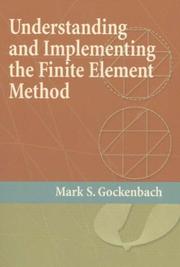
ISBN: 0898716144 9780898716146 Year: 2006 Publisher: Philadelphia, PA Society for Industrial and Applied Mathematics
Abstract | Keywords | Export | Availability | Bookmark
 Loading...
Loading...Choose an application
- Reference Manager
- EndNote
- RefWorks (Direct export to RefWorks)
Finite element method --- Data processing --- Finite element method. --- Data processing. --- FEA (Numerical analysis) --- FEM (Numerical analysis) --- Finite element analysis --- Numerical analysis --- Isogeometric analysis --- Finite element method - Data processing --- Acqui 2006
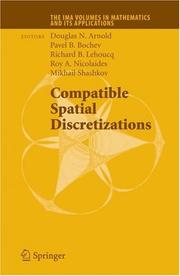
ISBN: 1280743808 9786610743803 0387380345 0387309160 1493901974 Year: 2006 Publisher: New York, N.Y. : Springer,
Abstract | Keywords | Export | Availability | Bookmark
 Loading...
Loading...Choose an application
- Reference Manager
- EndNote
- RefWorks (Direct export to RefWorks)
The IMA Hot Topics workshop on compatible spatialdiscretizations was held May 11-15, 2004 at the University of Minnesota. The purpose of the workshop was to bring together scientists at the forefront of the research in the numerical solution of PDEs to discuss recent advances and novel applications of geometrical and homological approaches to discretization. This volume contains original contributions based on the material presented at the workshop. A unique feature of the collection is the inclusion of work that is representative of the recent developments in compatible discretizations across a wide spectrum of disciplines in computational science. Compatible spatial discretizations are those that inherit or mimic fundamental properties of the PDE such as topology, conservation, symmetries, and positivity structures and maximum principles. The papers in the volume offer a snapshot of the current trends and developments in compatible spatial discretizations. The reader will find valuable insights on spatial compatibility from several different perspectives and important examples of applications compatible discretizations in computational electromagnetics, geosciences, linear elasticity, eigenvalue approximations and MHD. The contributions collected in this volume will help to elucidate relations between different methods and concepts and to generally advance our understanding of compatible spatial discretizations for PDEs. Abstracts and presentation slides from the workshop can be accessed at http://www.ima.umn.edu/talks/workshops/5-11-15.2004/.
Differential equations, Partial --- Finite element method --- Numerical solutions. --- Mathematics. --- FEA (Numerical analysis) --- FEM (Numerical analysis) --- Finite element analysis --- Numerical analysis --- Isogeometric analysis --- Differential equations, partial. --- Numerical analysis. --- Applications of Mathematics. --- Partial Differential Equations. --- Numerical Analysis. --- Partial differential equations --- Mathematical analysis --- Math --- Science --- Applied mathematics. --- Engineering mathematics. --- Partial differential equations. --- Engineering --- Engineering analysis --- Mathematics
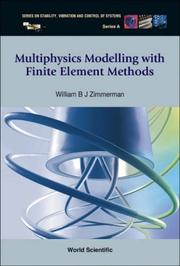
ISBN: 9789812568434 9812568433 Year: 2006 Volume: 18 Publisher: New Jersey, N.J. World Scientific
Abstract | Keywords | Export | Availability | Bookmark
 Loading...
Loading...Choose an application
- Reference Manager
- EndNote
- RefWorks (Direct export to RefWorks)
Information modeling --- Modèles d'information --- Information modeling. --- Éléments finis, Méthode des --- Modèles d'information --- Mathematical physics --- Finite element method. --- Finite element method --- Méthode des éléments finis --- Éléments finis, Méthode des. --- Modèles d'information. --- Monograph --- Modeling, Information --- System analysis --- FEA (Numerical analysis) --- FEM (Numerical analysis) --- Finite element analysis --- Numerical analysis --- Isogeometric analysis
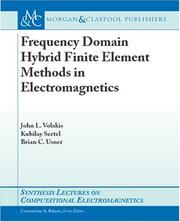
ISBN: 1598290819 9781598290813 1598290800 9781598290806 Year: 2006 Publisher: San Rafael, Calif. (1537 Fourth Street, San Rafael, CA 94901 USA) Morgan & Claypool Publishers
Abstract | Keywords | Export | Availability | Bookmark
 Loading...
Loading...Choose an application
- Reference Manager
- EndNote
- RefWorks (Direct export to RefWorks)
This book provides a brief overview of the popular Finite Element Method (FEM) and its hybrid versions for electromagnetics with applications to radar scattering, antennas and arrays, guided structures, microwave components, frequency selective surfaces, periodic media, and RF materials characterizations and related topics. It starts by presenting concepts based on Hilbert and Sobolev spaces as well as Curl and Divergence spaces for generating matrices, useful in all engineering simulation methods. It then proceeds to present applications of the finite element and finite element-boundary integral methods for scattering and radiation. Applications to periodic media, metamaterials and bandgap structures are also included. The hybrid volume integral equation method for high contrast dielectrics and is presented for the first time. Another unique feature of the book is the inclusion of design optimization techniques and their integration within commercial numerical analysis packages for shape and material design. To aid the reader with the method's utility, an entire chapter is devoted to two-dimensional problems. The book can be considered as an update on the latest developments since the publication of our earlier book (Finite Element Method for Electromagnetics, IEEE Press, 1998). The latter is certainly complementary companion to this one.
Electromagnetism --- Finite element method. --- Antennas (Electronics) --- Mathematics. --- FEA (Numerical analysis) --- FEM (Numerical analysis) --- Finite element analysis --- Finite elements. --- Integral equations. --- Volume integral methods. --- Hybrid techniques. --- Numerical methods. --- Antennas. --- Radiation. --- Radar scattering. --- Electromagnetics. --- Periodic media. --- Metamaterials. --- Design. --- Optimization. --- Electronic apparatus and appliances --- Numerical analysis --- Isogeometric analysis --- Antenna arrays. --- Electromagnetism. --- Electromagnetics --- Magnetic induction --- Magnetism --- Metamaterials --- Arrays, Antenna --- Large space structures (Astronautics)
Book
ISBN: 1281016527 9786611016524 008047277X 9780080472775 0750663200 9780750663205 Year: 2006 Publisher: Amsterdam Elsevier Butterworth-Heinemann
Abstract | Keywords | Export | Availability | Bookmark
 Loading...
Loading...Choose an application
- Reference Manager
- EndNote
- RefWorks (Direct export to RefWorks)
The Sixth Edition of this influential best-selling book delivers the most up-to-date and comprehensive text and reference yet on the basis of the finite element method (FEM) for all engineers and mathematicians. Since the appearance of the first edition 38 years ago, The Finite Element Method provides arguably the most authoritative introductory text to the method, covering the latest developments and approaches in this dynamic subject, and is amply supplemented by exercises, worked solutions and computer algorithms.The classic FEM text, written by the subject's leading authors
Finite element method. --- Engineering mathematics. --- Engineering --- Engineering analysis --- Mathematical analysis --- FEA (Numerical analysis) --- FEM (Numerical analysis) --- Finite element analysis --- Numerical analysis --- Isogeometric analysis --- Mathematics --- 519.63 --- 517.96 --- 517.96 Finite differences. Functional and integral equations --- Finite differences. Functional and integral equations --- 519.63 Numerical methods for solution of partial differential equations --- Numerical methods for solution of partial differential equations --- Mechanical properties of solids --- finite element method --- computer-aided engineering --- eindige elementen --- CAE (computer aided engineering)
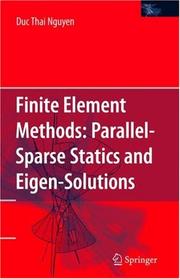
ISBN: 0387308512 0387293302 1441939857 Year: 2006 Publisher: New York, NY : Springer US : Imprint: Springer,
Abstract | Keywords | Export | Availability | Bookmark
 Loading...
Loading...Choose an application
- Reference Manager
- EndNote
- RefWorks (Direct export to RefWorks)
FEM, and the associated computer software are widely recognized as some of the most effective tools for solutions of large-scale engineering applications. Efficient equation and eigen-solvers play critical roles in solving these problems. Sparse matrix technologies have evolved and are now mature enough that all popular and commercialized FEM codes have inserted sparse solvers into their software. So far, however, few books include detailed discussion and explanation of sparse equation-solvers and Lanczos domain decomposition (DD) or finite element formulation for parallel computing purposes. The material in Finite Element Methods: Parallel-Sparse Statics and Eigen-Solutions has evolved over the past several years from the author's research work and his graduate courses. This book is ideal for graduate students, practicing engineers and researchers, as well as mathematicians and computer scientists. Dr. Duc T. Nguyen is the founding Director of the Institute for Multidisciplinary Parallel-Vector Computation and Professor of Civil and Environmental Engineering at Old Dominion University. Dr. Nguyen has been listed as an ISI Highly Cited Researcher™ in the field of engineering.
Engineering. --- Microprocessors. --- Applied mathematics. --- Engineering mathematics. --- Computer mathematics. --- Physics. --- Computational intelligence. --- Appl.Mathematics/Computational Methods of Engineering. --- Applications of Mathematics. --- Computational Intelligence. --- Numerical and Computational Physics. --- Processor Architectures. --- Computational Mathematics and Numerical Analysis. --- Intelligence, Computational --- Artificial intelligence --- Soft computing --- Natural philosophy --- Philosophy, Natural --- Physical sciences --- Dynamics --- Computer mathematics --- Discrete mathematics --- Electronic data processing --- Engineering --- Engineering analysis --- Mathematical analysis --- Minicomputers --- Construction --- Industrial arts --- Technology --- Mathematics --- Finite element method. --- FEA (Numerical analysis) --- FEM (Numerical analysis) --- Finite element analysis --- Numerical analysis --- Isogeometric analysis --- Mathematics. --- Computer science. --- Computer science --- Mathematical and Computational Engineering. --- Numerical and Computational Physics, Simulation. --- Informatics --- Science --- Math --- Numerical analysis.
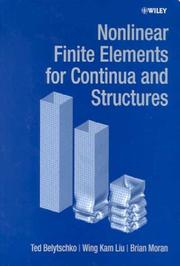
ISBN: 9780471987741 0471987743 0471987735 Year: 2006 Publisher: Chichester Wiley
Abstract | Keywords | Export | Availability | Bookmark
 Loading...
Loading...Choose an application
- Reference Manager
- EndNote
- RefWorks (Direct export to RefWorks)
517.96 --- 624.04 --- 624.04 Structural design. Graphical and analytical statics for investigation and calculation of structures --- Structural design. Graphical and analytical statics for investigation and calculation of structures --- 517.96 Finite differences. Functional and integral equations --- Finite differences. Functional and integral equations --- Milieux continus, Mécanique des --- Continuum mechanics --- Finite element method --- Structural analysis (Engineering) --- Mechanics of continua --- Elasticity --- Mechanics, Analytic --- Field theory (Physics) --- Architectural engineering --- Engineering, Architectural --- Structural mechanics --- Structures, Theory of --- Structural engineering --- FEA (Numerical analysis) --- FEM (Numerical analysis) --- Finite element analysis --- Numerical analysis --- Isogeometric analysis --- Continuum mechanics. --- Finite element method. --- Structural analysis (Engineering). --- Méthode des éléments finis --- Milieux continus, Mécanique des --- Constructions, Théorie des
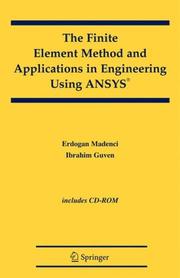
ISBN: 1280851945 9786610851942 0387282904 0387282890 Year: 2006 Publisher: New York, NY : Springer US : Imprint: Springer,
Abstract | Keywords | Export | Availability | Bookmark
 Loading...
Loading...Choose an application
- Reference Manager
- EndNote
- RefWorks (Direct export to RefWorks)
The Finite Element Method and Applications with ANSYS® provides the reader with theoretical and practical knowledge of the finite element method and with the skills required to analyze engineering problems with ANSYS®, a commercially available FEA program. This self-contained, introductory text minimizes the need for additional reference material, covering the fundamental topics in finite element methods, as well as advanced topics concerning modeling and analysis with ANSYS®. These subjects are introduced through extensive examples from various engineering disciplines and are presented in a clear, step-by-step fashion. The book focuses on the use of ANSYS® through both the Graphics User Interface (GUI) and the ANSYS® Parametric Design Language (APDL). This volume addresses these specific areas: An introduction to FEM Fundamentals and analysis capabilities of ANSYS®, with practical modeling considerations Fundamentals of discretization and approximation functions Modeling techniques and details of mesh generation in ANSYS® Creating solutions and reviewing results Finite element equations based on the method of weighted residuals and on the principle of minimum potential energy The use of commands and APDL and the development of macro files Example problems and solutions corresponding to linear structural analysis Example problems and solutions related to heat transfer and moisture diffusion Nonlinear structural problems Advanced subjects such as submodeling, substructuring, interaction with external files, and modification of ANSYS®-GUI Additional materials for this book, including the "input" files for the example problems, as well as the colored figures and screen shots, allowing them to be regenerated on the reader’s own computer, may be downloaded from http://extras.springer.com. Students, researchers, and practicing engineers will find this an essential reference for use in predicting and simulating the physical behavior of complex engineering systems using ANSYS®. .
Finite element method. --- ANSYS (Computer system) --- ANSYS Engineering Analysis System (Computer system) --- Computer systems --- Engineering --- FEA (Numerical analysis) --- FEM (Numerical analysis) --- Finite element analysis --- Numerical analysis --- Isogeometric analysis --- Data processing --- ANSYS (Computer system). --- Mechanical engineering. --- Engineering mathematics. --- Computer aided design. --- Computer simulation. --- Computer science. --- Mechanical Engineering. --- Mathematical and Computational Engineering. --- Computer-Aided Engineering (CAD, CAE) and Design. --- Simulation and Modeling. --- Computational Science and Engineering. --- Engineering, Mechanical --- Machinery --- Steam engineering --- Informatics --- Science --- Computer modeling --- Computer models --- Modeling, Computer --- Models, Computer --- Simulation, Computer --- Electromechanical analogies --- Mathematical models --- Simulation methods --- Model-integrated computing --- CAD (Computer-aided design) --- Computer-assisted design --- Computer-aided engineering --- Design --- Engineering analysis --- Mathematical analysis --- Mathematics --- Applied mathematics. --- Computer-aided engineering. --- Computer mathematics. --- Computer mathematics --- Electronic data processing --- CAE
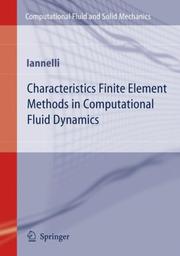
ISBN: 1280716665 9786610716661 3540453431 3540251812 3642064302 Year: 2006 Publisher: Berlin ; New York : Springer,
Abstract | Keywords | Export | Availability | Bookmark
 Loading...
Loading...Choose an application
- Reference Manager
- EndNote
- RefWorks (Direct export to RefWorks)
This book details a systematic characteristics-based finite element procedure to investigate incompressible, free-surface and compressible flows. The fluid dynamics equations are derived from basic thermo-mechanical principles and the multi-dimensional and infinite-directional upstream procedure is developed by combining a finite element discretization of a characteristics-bias system with an implicit Runge-Kutta time integration. For the computational solution of the Euler and Navier Stokes equations, the procedure relies on the mathematics and physics of multi-dimensional characteristics. As a result, the procedure crisply captures contact discontinuities, normal as well as oblique shocks, and generates essentially non-oscillatory solutions for incompressible, subsonic, transonic, supersonic, and hypersonic inviscid and viscous flows.
Physics. --- Computer mathematics. --- Continuum physics. --- Fluids. --- Applied mathematics. --- Engineering mathematics. --- Computational intelligence. --- Fluid mechanics. --- Classical Continuum Physics. --- Engineering Fluid Dynamics. --- Appl.Mathematics/Computational Methods of Engineering. --- Computational Science and Engineering. --- Fluid- and Aerodynamics. --- Computational Intelligence. --- Hydromechanics --- Continuum mechanics --- Intelligence, Computational --- Artificial intelligence --- Soft computing --- Engineering --- Engineering analysis --- Mathematical analysis --- Hydraulics --- Mechanics --- Physics --- Hydrostatics --- Permeability --- Classical field theory --- Continuum physics --- Computer mathematics --- Discrete mathematics --- Electronic data processing --- Natural philosophy --- Philosophy, Natural --- Physical sciences --- Dynamics --- Mathematics --- Finite element method. --- Fluid dynamics. --- Fluid mechanics --- FEA (Numerical analysis) --- FEM (Numerical analysis) --- Finite element analysis --- Numerical analysis --- Isogeometric analysis --- Hydraulic engineering. --- Computer science. --- Engineering. --- Classical and Continuum Physics. --- Mathematical and Computational Engineering. --- Construction --- Industrial arts --- Technology --- Informatics --- Science --- Engineering, Hydraulic --- Shore protection
Book
ISBN: 0750663219 Year: 2006 Publisher: Amsterdam Elsevier
Abstract | Keywords | Export | Availability | Bookmark
 Loading...
Loading...Choose an application
- Reference Manager
- EndNote
- RefWorks (Direct export to RefWorks)
- A proven keystone reference in the library of any engineer needing to apply the finite element method to solid mechanics and structural design. - Founded by an influential pioneer in the field and updated in this seventh edition by an author team incorporating academic authority and industrial simulation experience. - Features new chapters on topics including material constitution using representative volume elements, as well as consolidated and expanded sections on rod and shell models. The Finite Element Method *for Solid and Structural Mechanics* is the key text and reference for engineers, researchers and senior students dealing with the analysis and modeling of structures, from large civil engineering projects such as dams to aircraft structures and small engineered components. This edition brings a thorough update and rearrangement of the books content, including new chapters on: - Material constitution using representative volume elements - Differential geometry and calculus on manifolds - Background mathematics and linear shell theory Focusing on the core knowledge, mathematical and analytical tools needed for successful structural analysis and modeling, ***The Finite Element Method for Solid and Structural Mechanics*** is the authoritative resource of choice for graduate level students, researchers and professional engineers.
Mechanical properties of solids --- CAE (computer aided engineering) --- eindige elementen --- computer-aided engineering --- finite element method --- 539.4.01 --- prijs voor de 3 delen --- Continuum mechanics --- Finite element method --- Structural analysis (Engineering) --- algebra --- materialen --- mechanica --- niet-lineaire systemen --- sterkteleer --- toegepaste mechanica --- vaste stoffen --- wiskunde --- 519.63 --- 519.6 --- 519.63 Numerical methods for solution of partial differential equations --- Numerical methods for solution of partial differential equations --- Architectural engineering --- Engineering, Architectural --- Structural mechanics --- Structures, Theory of --- Structural engineering --- FEA (Numerical analysis) --- FEM (Numerical analysis) --- Finite element analysis --- Numerical analysis --- Isogeometric analysis --- Mechanics of continua --- Elasticity --- Mechanics, Analytic --- Field theory (Physics) --- Finite differences. Functional and integral equations --- Continuum mechanics. --- Finite element method. --- Structural analysis (Engineering). --- Element fini
| Listing 1 - 10 of 10 |
Sort by
|

 Search
Search Feedback
Feedback About UniCat
About UniCat  Help
Help News
News